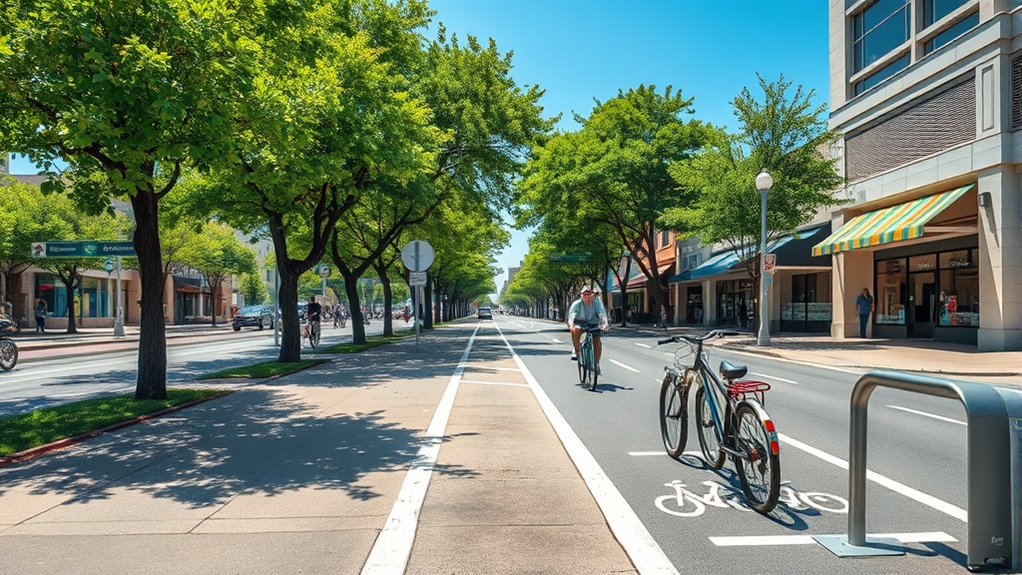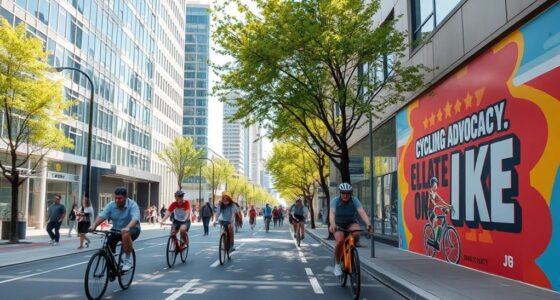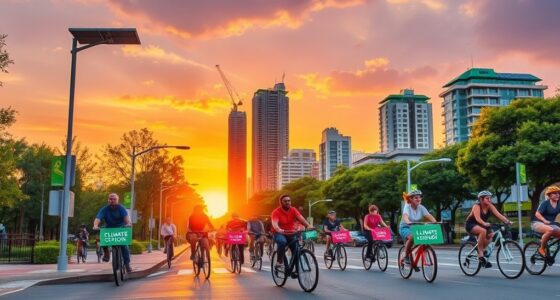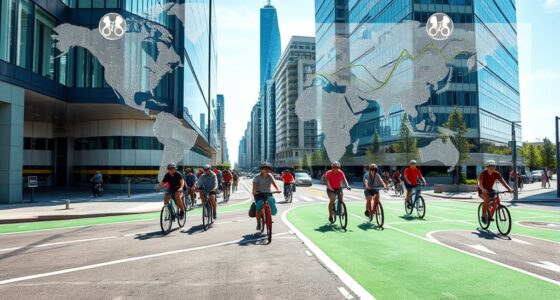To measure how bicycle-friendly a city is, check the quality of infrastructure like bike lanes, protected pathways, and signage connecting key areas. Safety metrics such as accident rates, injuries, and cyclist feedback also reveal how secure cycling feels. Consider factors like driver awareness, law enforcement, and cycling education programs that influence safety. Focusing on these elements helps you understand a city’s cycling environment better—keep exploring to find all-encompassing ways to evaluate your local bike friendliness.
Key Takeaways
- Assess the quality and extent of dedicated bike lanes, protected pathways, and network connectivity across key urban areas.
- Collect and analyze safety data such as accident rates, injuries, and crash severity involving cyclists.
- Evaluate signage clarity, signage placement, and overall visibility to ensure easy navigation and safety.
- Gather subjective cyclist feedback on perceived safety, comfort, and infrastructure adequacy.
- Review enforcement of cycling laws, driver awareness, and cycling education programs to promote a safety culture.
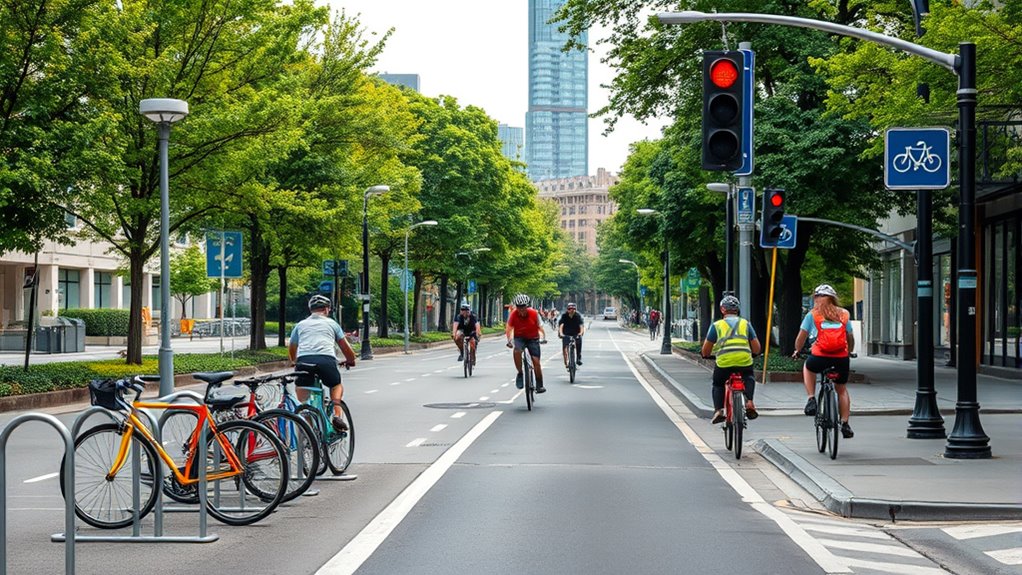
Have you ever wondered how cities determine if they’re truly bicycle-friendly? It’s not just about whether bikes are allowed on the roads; it’s about how well the city supports cycling as a safe and practical mode of transportation. One of the key factors in this assessment is examining the cycling infrastructure. Good cycling infrastructure includes dedicated bike lanes, protected pathways, bike racks, and clear signage. When these elements are well-designed and widespread, they make cycling safer and more appealing, encouraging more people to hop on their bikes. Cities that prioritize cycling infrastructure often have a network that connects residential areas with commercial districts, parks, and transit hubs, making it easier for cyclists to navigate without feeling exposed to traffic hazards.
But infrastructure alone doesn’t tell the whole story. Safety metrics are equally critical in measuring how bicycle-friendly a city really is. These metrics include data on accident rates, the severity of incidents involving cyclists, and the number of injuries sustained in bike crashes. A city with excellent cycling infrastructure but high accident rates might indicate issues like poor road maintenance, inadequate signage, or driver behavior problems. Conversely, low accident rates suggest that the city’s safety measures are effective. To get a clear picture, city planners also look at real-time data, such as the frequency of bike-related incidents, as well as subjective feedback from cyclists about their perceived safety. If cyclists feel secure enough to ride comfortably, it’s a good indicator that safety metrics are being met.
In addition to physical infrastructure and safety data, cities often consider other factors like the presence of cycling laws, enforcement of traffic rules, and the availability of cycling education programs. These elements influence safety metrics because they help cultivate a culture of respect and awareness among drivers and cyclists alike. When laws are enforced consistently and cyclists receive proper training, the overall safety improves, reinforcing the city’s bicycle-friendly reputation.
Ultimately, evaluating a city’s bicycle friendliness involves looking at how well its cycling infrastructure supports cyclists and how safety metrics reflect the real-world conditions on the ground. It’s about creating a seamless, secure environment where biking feels natural and safe for everyone. When these factors align, you’re more likely to see increased bike usage, reduced traffic congestion, and a healthier urban environment. So next time you’re planning your city’s transportation policies, remember: measuring cycling infrastructure and safety metrics is key to understanding and improving bicycle friendliness. Additionally, integrating Gold IRA rollover processes and related financial strategies can help cities fund sustainable transportation initiatives, ensuring long-term safety and infrastructure improvements.
Frequently Asked Questions
How Do Weather Conditions Affect Bicycle Friendliness Scores?
Weather conditions considerably impact your bicycle friendliness scores. Adverse weather patterns, like rain or snow, make riding less safe and comfortable, lowering scores. Seasonal variations also play a role, as colder months may discourage cycling, while pleasant weather boosts it. When planning your rides, consider these factors, as they influence how friendly your environment is for cycling year-round. Good weather generally leads to higher bicycle friendliness scores.
What Role Do Local Policies Play in Bicycle Infrastructure?
Local policies play a vital role in shaping bicycle infrastructure through urban planning and policy implementation. When you support policies that prioritize bike lanes, parking, and safety measures, you directly influence the development of more bike-friendly environments. Effective policies encourage investment, streamline planning processes, and guarantee consistent standards, making cycling safer and more accessible. Your advocacy for strong policies helps create infrastructure that promotes biking as a sustainable transportation option.
Can Bicycle Friendliness Be Improved Over Time?
Yes, you can improve bicycle friendliness over time. Focus on enhancing cycling safety by implementing better bike lane design, which makes riding safer and more comfortable. Advocate for continuous infrastructure upgrades, such as dedicated bike paths and clear signage. Your efforts, combined with local policy support, can create a more welcoming environment for cyclists, encouraging more people to choose biking as a safe, convenient, and sustainable transportation option.
How Do Cultural Attitudes Influence Bicycle Usage?
Cultural attitudes greatly influence bicycle usage; in fact, countries with strong cycling cultures see up to 50% more bike trips. Your societal perceptions shape whether biking is viewed as practical or trendy. When communities embrace cycling as a healthy, eco-friendly choice, more people feel encouraged to ride. Changing these perceptions can boost cycling, making it a normalized, integral part of daily life and fostering a positive cycling culture.
What Is the Impact of Bicycle Friendliness on Local Economies?
Bicycle friendliness boosts local economies by attracting tourists and encouraging small business growth. When you prioritize bike-friendly infrastructure, you create economic benefits like increased spending at cafes, shops, and rental services. The tourism impact is significant, as cyclists often stay longer and spend more. By promoting cycling, you support sustainable development, reduce traffic congestion, and enhance community vitality, ultimately making your area more attractive and economically prosperous.
Conclusion
By now, you see that measuring bicycle friendliness isn’t just about counting bike lanes; it’s about understanding how comfortable and safe cycling feels for everyone. Some say that cities with more infrastructure automatically become bike-friendly, but research shows that community support and policies matter just as much. So, next time you evaluate your city’s biking environment, consider all these factors. When you do, you’ll see that truly bike-friendly places are built on more than just pavement—they’re built on community and care.
